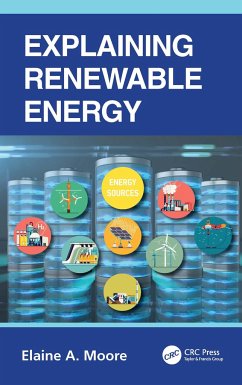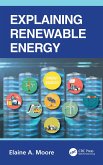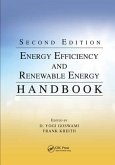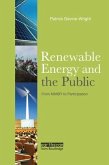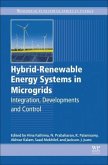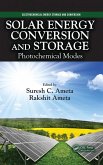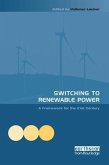Elaine A. Moore (The Open University, Milton Keynes, UK)
Explaining Renewable Energy
Elaine A. Moore (The Open University, Milton Keynes, UK)
Explaining Renewable Energy
- Broschiertes Buch
- Merkliste
- Auf die Merkliste
- Bewerten Bewerten
- Teilen
- Produkt teilen
- Produkterinnerung
- Produkterinnerung
Renewable energy is the solution to mitigation of fossil carbon emissions. Understanding the principles, advantages and challenges of renewable energy will help accelerate wider adoption of renewable energy solutions and carbon mitigation.
Andere Kunden interessierten sich auch für
![Explaining Renewable Energy Explaining Renewable Energy]() Elaine A. Moore (The Open University, Milton Keynes, UK)Explaining Renewable Energy98,99 €
Elaine A. Moore (The Open University, Milton Keynes, UK)Explaining Renewable Energy98,99 €![Energy Efficiency and Renewable Energy Handbook Energy Efficiency and Renewable Energy Handbook]() Energy Efficiency and Renewable Energy Handbook176,99 €
Energy Efficiency and Renewable Energy Handbook176,99 €![Renewable Energy Powered Desalination Handbook Renewable Energy Powered Desalination Handbook]() Gnaneswar GudeRenewable Energy Powered Desalination Handbook151,99 €
Gnaneswar GudeRenewable Energy Powered Desalination Handbook151,99 €![Renewable Energy and the Public Renewable Energy and the Public]() Renewable Energy and the Public51,99 €
Renewable Energy and the Public51,99 €![Hybrid-Renewable Energy Systems in Microgrids Hybrid-Renewable Energy Systems in Microgrids]() Hybrid-Renewable Energy Systems in Microgrids163,99 €
Hybrid-Renewable Energy Systems in Microgrids163,99 €![Solar Energy Conversion and Storage Solar Energy Conversion and Storage]() Solar Energy Conversion and Storage59,99 €
Solar Energy Conversion and Storage59,99 €![Switching to Renewable Power Switching to Renewable Power]() Switching to Renewable Power32,99 €
Switching to Renewable Power32,99 €-
-
-
Renewable energy is the solution to mitigation of fossil carbon emissions. Understanding the principles, advantages and challenges of renewable energy will help accelerate wider adoption of renewable energy solutions and carbon mitigation.
Produktdetails
- Produktdetails
- Verlag: Taylor & Francis Ltd
- Seitenzahl: 104
- Erscheinungstermin: 16. Dezember 2022
- Englisch
- Abmessung: 234mm x 156mm x 7mm
- Gewicht: 180g
- ISBN-13: 9781032275758
- ISBN-10: 1032275758
- Artikelnr.: 65615201
- Herstellerkennzeichnung
- Libri GmbH
- Europaallee 1
- 36244 Bad Hersfeld
- gpsr@libri.de
- Verlag: Taylor & Francis Ltd
- Seitenzahl: 104
- Erscheinungstermin: 16. Dezember 2022
- Englisch
- Abmessung: 234mm x 156mm x 7mm
- Gewicht: 180g
- ISBN-13: 9781032275758
- ISBN-10: 1032275758
- Artikelnr.: 65615201
- Herstellerkennzeichnung
- Libri GmbH
- Europaallee 1
- 36244 Bad Hersfeld
- gpsr@libri.de
Elaine A. Moore has worked in hospital laboratories for more than 30 years, primarily in immunohematology and toxicology. She is a freelance medical writer and laboratory consultant. For more information, visit her website at www.elaine-moore.com. She lives in Sedalia, Colorado.
1. Introduction
2. Solar Energy
2.1. Photovoltaic (solar) cells
2.1.1 Semiconductors
2.1.2. The p-n junction
2.1.3. Materials
2.1.4. Other solar cells
2.2. Other Considerations
2.3. Solar thermal panels
2.3.1 Materials
2.3.2 Other Considerations
Questions
3. Wind power
3.1. Wind turbines
3.2. Electrical generators
3.3. Materials
3.4. Other Considerations
Questions
4. Water power
4.1. Hydroelectric dams
4.2. River turbines
4.3. Wave power
4.4. Tidal power
4.5. Material
4.6. Other Considerations
Questions
5. Geothermal Energy
5.1. The origin of geothermal energy
5.2. Accessing geothermal energy
5.2.1 Using geothermal energy for heating
5.2.2 Using geothermal energy to produce electricity
5.3. Considerations
Questions
6. Hydrogen
6.1. Hydrogen production
6.1.1. Electrolysis
6.1.2. Chemical Reactions
6.1.3. Biohydrogen production
6.2. Storage and transport
6.3. Hydrogen use
6.3.1. Fuel cells
6.4. Considerations
Questions
7. Biomass
7.1. How is energy produced from biomass?
7.2. Why is energy derived from biomass considered renewable?
7.3. Types of biomass
7.3.1. Wood
7.3.2. Crops and Grasses
7.3.3. Algae
7.3.4. Waste
7.4. Considerations
Questions
8. Energy storage
8.1. How rechargeable batteries work
8.2. Batteries for storage
8.2.1 Kead-acid batteries
8.2.2. Lithium-ion batteries
8.2.3. Sodium based batteries
8.2.4. Redox flow batteries
8.3. Batteries for transport
8.3.1. Lithium-based batteries
8.4. Capacitors
8.5. Pumped storage hydropower
Questions
9. Carbon capture, storage and conversion
9.1. Carbon capture and storage
9.1.1. Trees and peat bogs
9.1.2. Construction materials and minerals
9.1.3. Porous solids
9.1.4. Absorbance by liquids
9.2. Conversion of captured carbon dioxide
9.2.1. Mineralisation
9.2.2 Chemicals and Fuels
Questions
2. Solar Energy
2.1. Photovoltaic (solar) cells
2.1.1 Semiconductors
2.1.2. The p-n junction
2.1.3. Materials
2.1.4. Other solar cells
2.2. Other Considerations
2.3. Solar thermal panels
2.3.1 Materials
2.3.2 Other Considerations
Questions
3. Wind power
3.1. Wind turbines
3.2. Electrical generators
3.3. Materials
3.4. Other Considerations
Questions
4. Water power
4.1. Hydroelectric dams
4.2. River turbines
4.3. Wave power
4.4. Tidal power
4.5. Material
4.6. Other Considerations
Questions
5. Geothermal Energy
5.1. The origin of geothermal energy
5.2. Accessing geothermal energy
5.2.1 Using geothermal energy for heating
5.2.2 Using geothermal energy to produce electricity
5.3. Considerations
Questions
6. Hydrogen
6.1. Hydrogen production
6.1.1. Electrolysis
6.1.2. Chemical Reactions
6.1.3. Biohydrogen production
6.2. Storage and transport
6.3. Hydrogen use
6.3.1. Fuel cells
6.4. Considerations
Questions
7. Biomass
7.1. How is energy produced from biomass?
7.2. Why is energy derived from biomass considered renewable?
7.3. Types of biomass
7.3.1. Wood
7.3.2. Crops and Grasses
7.3.3. Algae
7.3.4. Waste
7.4. Considerations
Questions
8. Energy storage
8.1. How rechargeable batteries work
8.2. Batteries for storage
8.2.1 Kead-acid batteries
8.2.2. Lithium-ion batteries
8.2.3. Sodium based batteries
8.2.4. Redox flow batteries
8.3. Batteries for transport
8.3.1. Lithium-based batteries
8.4. Capacitors
8.5. Pumped storage hydropower
Questions
9. Carbon capture, storage and conversion
9.1. Carbon capture and storage
9.1.1. Trees and peat bogs
9.1.2. Construction materials and minerals
9.1.3. Porous solids
9.1.4. Absorbance by liquids
9.2. Conversion of captured carbon dioxide
9.2.1. Mineralisation
9.2.2 Chemicals and Fuels
Questions
1. Introduction
2. Solar Energy
2.1. Photovoltaic (solar) cells
2.1.1 Semiconductors
2.1.2. The p-n junction
2.1.3. Materials
2.1.4. Other solar cells
2.2. Other Considerations
2.3. Solar thermal panels
2.3.1 Materials
2.3.2 Other Considerations
Questions
3. Wind power
3.1. Wind turbines
3.2. Electrical generators
3.3. Materials
3.4. Other Considerations
Questions
4. Water power
4.1. Hydroelectric dams
4.2. River turbines
4.3. Wave power
4.4. Tidal power
4.5. Material
4.6. Other Considerations
Questions
5. Geothermal Energy
5.1. The origin of geothermal energy
5.2. Accessing geothermal energy
5.2.1 Using geothermal energy for heating
5.2.2 Using geothermal energy to produce electricity
5.3. Considerations
Questions
6. Hydrogen
6.1. Hydrogen production
6.1.1. Electrolysis
6.1.2. Chemical Reactions
6.1.3. Biohydrogen production
6.2. Storage and transport
6.3. Hydrogen use
6.3.1. Fuel cells
6.4. Considerations
Questions
7. Biomass
7.1. How is energy produced from biomass?
7.2. Why is energy derived from biomass considered renewable?
7.3. Types of biomass
7.3.1. Wood
7.3.2. Crops and Grasses
7.3.3. Algae
7.3.4. Waste
7.4. Considerations
Questions
8. Energy storage
8.1. How rechargeable batteries work
8.2. Batteries for storage
8.2.1 Kead-acid batteries
8.2.2. Lithium-ion batteries
8.2.3. Sodium based batteries
8.2.4. Redox flow batteries
8.3. Batteries for transport
8.3.1. Lithium-based batteries
8.4. Capacitors
8.5. Pumped storage hydropower
Questions
9. Carbon capture, storage and conversion
9.1. Carbon capture and storage
9.1.1. Trees and peat bogs
9.1.2. Construction materials and minerals
9.1.3. Porous solids
9.1.4. Absorbance by liquids
9.2. Conversion of captured carbon dioxide
9.2.1. Mineralisation
9.2.2 Chemicals and Fuels
Questions
2. Solar Energy
2.1. Photovoltaic (solar) cells
2.1.1 Semiconductors
2.1.2. The p-n junction
2.1.3. Materials
2.1.4. Other solar cells
2.2. Other Considerations
2.3. Solar thermal panels
2.3.1 Materials
2.3.2 Other Considerations
Questions
3. Wind power
3.1. Wind turbines
3.2. Electrical generators
3.3. Materials
3.4. Other Considerations
Questions
4. Water power
4.1. Hydroelectric dams
4.2. River turbines
4.3. Wave power
4.4. Tidal power
4.5. Material
4.6. Other Considerations
Questions
5. Geothermal Energy
5.1. The origin of geothermal energy
5.2. Accessing geothermal energy
5.2.1 Using geothermal energy for heating
5.2.2 Using geothermal energy to produce electricity
5.3. Considerations
Questions
6. Hydrogen
6.1. Hydrogen production
6.1.1. Electrolysis
6.1.2. Chemical Reactions
6.1.3. Biohydrogen production
6.2. Storage and transport
6.3. Hydrogen use
6.3.1. Fuel cells
6.4. Considerations
Questions
7. Biomass
7.1. How is energy produced from biomass?
7.2. Why is energy derived from biomass considered renewable?
7.3. Types of biomass
7.3.1. Wood
7.3.2. Crops and Grasses
7.3.3. Algae
7.3.4. Waste
7.4. Considerations
Questions
8. Energy storage
8.1. How rechargeable batteries work
8.2. Batteries for storage
8.2.1 Kead-acid batteries
8.2.2. Lithium-ion batteries
8.2.3. Sodium based batteries
8.2.4. Redox flow batteries
8.3. Batteries for transport
8.3.1. Lithium-based batteries
8.4. Capacitors
8.5. Pumped storage hydropower
Questions
9. Carbon capture, storage and conversion
9.1. Carbon capture and storage
9.1.1. Trees and peat bogs
9.1.2. Construction materials and minerals
9.1.3. Porous solids
9.1.4. Absorbance by liquids
9.2. Conversion of captured carbon dioxide
9.2.1. Mineralisation
9.2.2 Chemicals and Fuels
Questions

